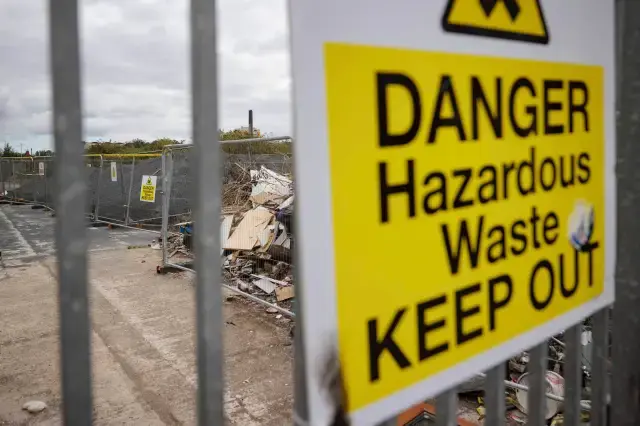-
Hamas Issues New Warning to Trump - 14 mins ago
-
With L.A. mayor focused on trash, her top sanitation official departs - 18 mins ago
-
What to Watch at the Federal Reserve’s October Meeting - 31 mins ago
-
Beaver Moon 2025: How To Best See November’s Supermoon - 49 mins ago
-
Report asks why LAPD mental health specialists defer to armed officers - 60 mins ago
-
Israeli Strikes in Gaza Kill at Least 100, Local Health Officials Say - about 1 hour ago
-
Zohran Mamdani delivers warning to Donald Trump - about 1 hour ago
-
ICE officials in major cities replaced with Border Patrol - 2 hours ago
-
Shop the Detroit Lions lululemon Collection: NFL’s New Premium Team Gear - 2 hours ago
-
‘Not Very Much Survives a Category 5,’ and the Use of Tear Gas in Chicago - 2 hours ago
New EPA rule could allow more use of toxic chemicals
The Environmental Protection Agency (EPA) has proposed a new rule regarding the regulation of toxic chemicals that would give the agency the authority to decide whether these chemicals are safe to use in certain conditions.
The EPA could therefore determine that chemicals listed in the Toxic Substances Control Act (TSCA)—which includes asbestos, formaldehyde, mercury and lead—were acceptable to use in specific circumstances.
Why It Matters
The proposed rule has sparked significant concern among experts who argue that it is a major win for certain industries and puts Americans at risk.
“The rule is designed to make it far easier for manufacturers of toxic and potentially toxic chemicals to win approval from EPA to market their products without taking the time to conduct adequate risk assessments,” Rena Steinzor, a professor of law at the University of Maryland, told Newsweek.
She added that the “tragedies of black lung disease, benzene exposure, and inhalation of asbestos could all be duplicated in different contexts as a result of this rule.”

What To Know
The EPA published the proposed rule, titled “Procedures for Chemical Risk Evaluation Under the Toxic Substances Control Act (TSCA),” in the Federal Register on September 23.
The agency has said the rule will ensure it can “more efficiently and effectively protect human health and the environment,” as it asserts that the chemicals review process has been affected by delays.
Noah Sachs, a professor of law and director of the Robert R. Merhige Jr. Center for Environmental Studies at the University of Richmond, Virginia, told Newsweek, “Delays in the program are mainly due to insufficient staffing and budgets and to endless litigation brought by industry, not to the fine print of EPA regulations.”
The rule would alter a number of revisions that the Biden administration’s EPA brought in, such as changing the 2024 evaluation process of a single determination of risk associated with a toxic chemical to a situation where that chemical would be risk evaluated when used in different circumstances.
The EPA told Newsweek that the TSCA currently requires it to determine whether a chemical presents “an unreasonable risk of injury to health or the environment, without consideration of costs or other non-risk factors.”
“Even if a chemical has potential risk, it does not necessarily mean EPA will find that the risk is unreasonable,” the agency said.
In its evaluations, the agency said it would consider “the severity of the hazard, exposure-related considerations, and the population potentially exposed.”
This could lessen the regulation of toxic chemicals, as it could mean some are allowed to be used in certain situations, which Sachs said “weakens public health protections that were put in place under the Biden administration.”
The rule allows the EPA to decide which conditions of use and exposure pathways it reviews when determining if a chemical is toxic, whereas the 2024 rules make it obligatory for the agency to consider every condition of use and every exposure route and pathway.
This change in particular has raised significant concern among experts, as it could “relieve the agency and manufacturers from the obligation of considering all potential pathways of the public’s exposure to the chemical as it traverses the marketplace,” Steinzor said.
For example, she added, a decision to include a “potentially toxic chemical” in laundry soap may not be fully examined if made after the EPA’s new review of chemical safety.
This rule would also change the way the EPA considers risk to workers in regards to toxic chemicals. The 2024 rule limits the EPA’s ability to assume that workers always use personal protective equipment when calculating risk, while the new rule would allow the EPA to instead consider “reasonably available information on the implementation and use of occupational exposure control measures such as engineering and administrative controls and personal protective equipment.”
The EPA told Newsweek that the agency would also consider whether available information indicates if “there is an absence or ineffective use of such controls.”
What People Are Saying
Rena Steinzor, a professor of law at the University of Maryland, told Newsweek: “The proposal rolls back more protective rules implemented during the Biden administration. In the context of the shocking cutbacks in EPA staff, especially scientists able to conduct independent evaluations of toxic chemicals, the public can no longer be confident that chemical safety is supervised effectively by government.”
She added: “The proposed rule scraps the Biden requirement that EPA consider as part of the risk assessment whether chemical workers have adequate protections on the factory floor. The 2016 TSCA amendments clearly require that such threats be included in the examination of chemical safety.”
Cary Coglianese, a professor of law and political science and the director of the Penn Program on Regulation at the University of Pennsylvania, told Newsweek: “One of the aspects that stands out from an administrative law perspective is that the Trump EPA is claiming that it has found a new ‘best reading’ of the underlying statute—TSCA—within a span of 18 months. The new EPA is going to try to defend its deregulatory move here by claiming that the agency actually didn’t have authority to take a regulatory action that it took just a year and a half ago. Other than a change in administration, though, there’s really nothing that has changed in the statute’s wording, so this change in statutory interpretation seems to be driven in reality by a change in policy preferences by the new administration.”
He added: “A key implication for public health will be that, if EPA finalizes this rule, the agency will have less information available to it on which to base its decision-making about risk management of toxic chemicals. A broader implication lies in how the EPA is proposing to justify its regulatory change in a changed interpretation of the ‘best reading’ of the statute. We will have to see how the courts respond to this type of justification because it is an approach that the Trump administration is taking with respect to many other of its deregulatory initiatives.”
EPA Administrator Lee Zeldin said in a news release: “The American public and the businesses that drive our nation’s great economy need to have confidence in the safety of chemicals reviewed by EPA. That’s why today’s proposal lays out a clear, predictable, commonsense approach that’s grounded in the law and the science. This work is yet another example of how we can and will protect human health and the environment while allowing manufacturing and industrial sectors to thrive.”
What Happens Next
The public is able to comment on the proposed rule until November 7.
So far comments have included the New York State Department of Environmental Conservation requesting more time to review the proposed changes and a member of the public saying the changes “increase the potential for underestimating risk” of the chemicals. Another American wrote, “The Trump EPA is more concerned about private business profits than Americans’ health and their environment’s safety.”
While the EPA is proposing to change current risk evaluations in the TSCA, the agency told Newsweek that the risk management process was “distinct” under the act, meaning the EPA would continue to follow the act’s risk management rules, even though it is hoping to adapt the risk evaluation rules.
Newsweek‘s full interview with Noah Sachs, a professor of law and the director of the Robert R. Merhige Jr. Center for Environmental Studies at the University of Richmond
What is your reaction to this proposed rule?
The rule weakens public health protections that were put in place under the Biden administration and largely goes back to the interpretation of the statute that the first Trump EPA used. It’s not surprising that EPA is rolling back protections under TSCA given that the chemicals office at EPA is now headed by former executives and lobbyists for the American Chemistry Council, the main chemical industry trade group. Industry is literally writing its own rulebook here.
Why do you think the EPA is proposing these changes?
EPA says this is about streamlining and speeding up the chemicals review process, which has been plagued by delays. But the delays in the program are mainly due to insufficient staffing and budgets and to endless litigation brought by industry, not to the fine print of EPA regulations. Congress is also at fault because it established a chemical-by-chemical review process that will require decades to review the risks of the most common industrial chemicals. EPA does not evaluate the risks of classes of chemicals at once. Also, most of the changes in this new rule were on the “wish list” of the National Association of Manufacturers that was submitted to the incoming Trump administration after the 2024 election.
What are the main aspects of this rule that stand out to you the most and why?
Definitely the most troubling aspect is the reversion to the earlier Trump policy of conducting a risk evaluation on each “condition of use” of a chemical. EPA says this will speed things up because if the agency finds an unreasonable risk from one use of a chemical (like in consumer goods), it can launch a regulatory process without waiting for the data on every other use of the chemical. This is a piecemeal approach to evaluating chemical risks because we know that Americans are exposed to the same hazardous chemical in multiple contexts (air, water, products, and workplaces). The Biden administration’s “whole chemical” approach took into account these multiple exposures.
What implications do you think it could have more broadly?
It’s no secret that the Trump administration is rolling back environmental regulations across the board to benefit industry backers. This is just one example of a much larger deregulatory project that will increase hazardous emissions across the U.S.
Timeline is probably spring 2026 to release the final rule, and then I expect environmental and public health groups to sue to challenge it. That litigation could easily take a year.
Source link


















